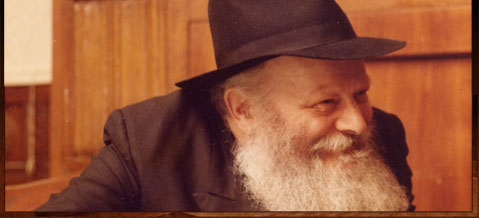Rabbi Avraham Chaputa
This story is an excerpt from the book My Story 2: Lives Changed. Get your copy today at www.jemstore.com.
Yeshivat HaRambam U’Beit Yosef, a Sephardi yeshivah, was founded in Tel Aviv in 1955, and at that time I was appointed its head though I was only twenty. Of course, it was a small yeshivah back then, but it grew and grew. And, after a time, I was looking for a place where we could grow even more.
In 1972, I traveled to the United States to raise money for a building site and construction. At that time, a few donors to the yeshivah – businessmen who were Israelis and who happened to be in the United States just then – met me and said they had an appointment to see the Lubavitcher Rebbe. They asked me to join them and I agreed, although I knew very little about the Rebbe.
As I recall, the meeting was late at night. We went into the Rebbe’s office, and my companions asked whatever they wanted to ask – as I recall they were seeking advice on business matters; the Rebbe blessed them, and we got ready to leave. Up to that point, I hadn’t uttered a word, but suddenly, the Rebbe said, “The rabbi who is with you should stay.” And then he rose from his chair and addressed me directly, “Are you Rabbi Avraham Chaputa?”
I was surprised that he knew my name.
I replied in the affirmative, and he asked me to sit down and began talking with me. This conversation lasted a long time, at least forty-five minutes. He spoke easily in pure Hebrew, smiling all the while. I would say it was a wonderful conversation, a very comfortable conversation as far as I was concerned.
Every time one of the Rebbe’s secretaries opened the door, they saw that the Rebbe was still talking with me, so they left us alone. They opened the door every few minutes, because there were a lot of people waiting outside; but, this didn’t affect the Rebbe at all. He continued speaking with me, asking me all sorts of questions about the yeshivah, the students, the lessons, etc. I also mentioned that we were petitioning the city to obtain a new building site because the yeshivah had grown.
Before the meeting ended, he asked me to please include some Chabad teachings when I spoke to my students. I responded by saying that my talks were usually varied – in addition to Sephardic sources and teachings of Maimonides, they also included teachings from the various Ashkenazi schools of thought, including Mussar (the Jewish ethical movement), the Lithuanian yeshivah world, and the Chasidism of the Baal Shem Tov. However, I understood that he specifically wanted some Chabad teachings in my talks. As I had previously studied the Tanya, the seminal work by the founder of the Chabad movement, I agreed to do so.
As I was leaving, I mentioned that I had published many books, and he asked to read them, saying to his secretary, “Whatever book Rabbi Chaputa sends, please bring to me right away. And any Chabad book that he wants, please give him before he leaves.”
I returned to Tel Aviv and – as amazing as it seemed at the time – within a short time the secular city officials gave us a plot to build a new yeshivah.
Around that time, I had been appointed to the Tel Aviv Religious Council, and I thought that the donation of this plot of land had something to do with my recognition by Rabbi Isser Yehudah Unterman, who had been the Chief Rabbi of Tel Aviv and who became the Chief Rabbi of Israel.
But I was wrong.
I only discovered what actually took place thirty-four years later, in 2006, when celebrations were held in honor of finishing the annual cycle of studying Maimonides’s fourteen-volume magnum opus on Jewish law, Mishneh Torah. These cycles began in 1984, when the Rebbe instituted the practice of studying Mishneh Torah every day. As the leader of a yeshivah whose core curriculum focused on Maimonides, I was invited by Chabad to participate in beginning the new cycle of study. Of course, I agreed. But the night I went to speak there, I got a shock.
Someone showed me a copy of a letter that the Rebbe had written in October of 1972 to Yehoshua Rabinovitz, then mayor of Tel Aviv, which read in part:
It is possible that my letter will surprise you, since we have never had the opportunity to meet or come in contact, etc., but as it is about a matter of public concern, I hope you will be receptive to my request, especially since the satisfactory resolution of this matter depends wholly on you….
This matter concerns the Yeshivat HaRambam located in Hadar Yosef, Tel Aviv. As I have been informed, across from the yeshivah sits a plot of land which has been the subject of efforts by the yeshivah to acquire, but the formal permission for “a change of designation” has been dragging….
Although I don’t know the details and difficulties of the matter, I do know that this touches upon the foundational matter of public Torah study – particularly an institution of the Sephardic community, whose youth have unique challenges: primarily problems with absorption after having been uprooted from the countries where their families have lived for hundreds of years and, now, after coming to the Holy Land, they must adapt to living conditions entirely different from what they are used to, etc. – certainly this issue is worthy of extra attention and your assistance beyond the letter of the law, and even more than that….
I am writing to support their request and to add my request as well, doubled and multiplied, to assist the aforementioned yeshivah’s development in general – and in particular, that the desired plot be given to them, which, according to their request, is located close by….
I was astounded – the Rebbe was requesting that the mayor give us a plot for our yeshivah! In that meeting, he had heard me say that I needed a plot of land so that we could expand and admit more students. But I had not asked him to help me, nor did I expect him to. Yet he took it upon himself to do what he could to secure this plot for us.
His eyes were open and watching over so many places – he was not just a Rebbe to his chasidim; he cared about the entire Jewish world.
It was really a wondrous thing. I have no doubt at all that the Rebbe’s request played a pivotal role in our receiving the land.
We built a very large building, which accommodates hundreds of students.
And a good part of that I credit to the Rebbe’s intervention. He saw the whole world before him. And he cared. And he acted.
Rabbi Avraham Chaputa, an author of more than fifty books, serves as the head of the Kollel Midrash HaRambam in Petach Tikvah, Israel. Previously, he served as the head of Yeshivat HaRambam U’Beit Yosef in Tel Aviv for close to three decades. He was interviewed in his home in Petach Tikvah in March of 2013.





